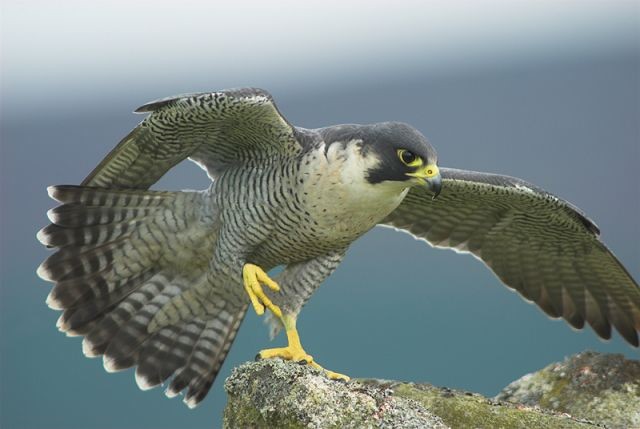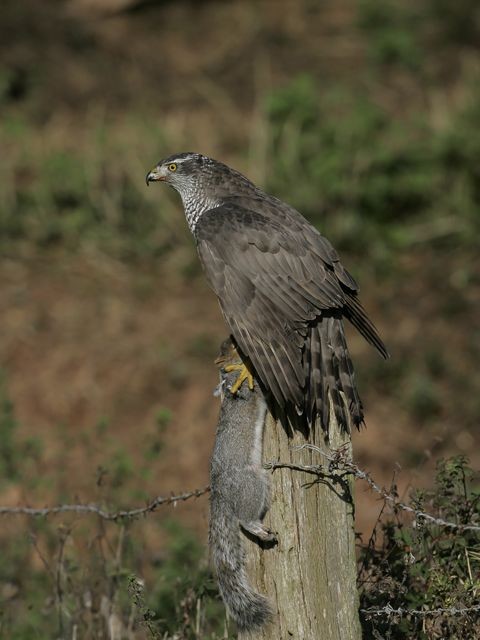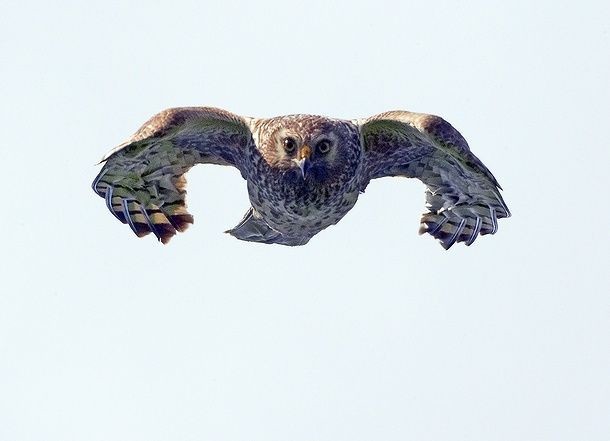launches campaign to stamp out bird of prey slaughter
The RSPB is today launching a campaign to stamp out the illegal killing of the UK's birds of prey, which research shows are being slaughtered in large numbers in parts of the UK. Information from northern England suggests that persecution is rife, including in some of our best-loved national places, such as the north Pennines, the Yorkshire Dales, the North York Moors and the Peak District. Every year, birds of prey - such as Golden Eagles, Hen Harriers, Goshawks, Buzzards, Red Kites, and Peregrine Falcons - are being slaughtered by unscrupulous gamekeepers and shooting estates. This relentless persecution is putting the Hen Harrier at risk in England - where last year only 15 pairs nested successfully - and will prevent the Golden Eagle from recolonising northern England from Southern Scotland.

Peregrine Falcon, undisclosed site, Dumfries & Galloway (Photo:
Keith Kirk)
The RSPB is challenging landowners and land managers to help boost the number of English nesting Hen Harriers to 40 by 2010, with half of these on grouse moors. Previously published research suggests that England has suitable habitat for more than five times that number. Dr Mark Avery, the RSPB's conservation director, said: "It is outrageous that birds of prey are still being killed illegally and that these fantastic birds are destroyed before they can cast their shadows on some of our most beautiful wild places. The skies are owned by no-one, but a callous few want to deprive the nation of some of our most charismatic wildlife."
Although the populations of many birds of prey are rising in some parts of the UK, especially the lowlands, in black holes - especially in the uplands - gamekeepers and shooting estates are systematically wiping out these iconic species. Last year, only 15 pairs of Hen Harrier nested successfully in England - well short of our conservative target of 40 nests in England by 2010. Two pairs of Hen Harrier nested in the Peak District in 2006, but the males disappeared in mysterious circumstances, meaning the chicks had to be fed artificially to keep them alive. These attempts, and one in 1997, were the only successful attempts in the last 140 years for the Peak District.

Goshawk, Forest of Dean, Gloucestershire (Photo:
Mark Hancox)
This year, thanks to the creation of a Hen Harrier hotline, there are early reports of birds establishing territories in Northumberland and the Peak District and North Yorkshire Moors. Dr Mark Avery said: "Visitors to the Peak District, the Yorkshire Dales and the North York Moors would rightly expect to see a diversity of birds of prey, but our initial evidence shows these birds are being targeted before the birds can establish themselves. This year we are calling on upland shooting estates to allow birds of prey to nest successfully."
Perhaps most at risk are those birds of prey, such as Eagles, Peregrine Falcons and Hen Harriers, which have the misfortune to nest in upland areas that are dominated by grouse shooting. Dr Mark Avery added: "We can only improve the fortunes of Hen Harriers and other birds of prey with the help and commitment of moorland owners and managers. For decades, we have worked to improve the situation but in large areas of upland Britain progress has stalled and in some is worsening. The intransigence of some estates has led to a stalemate, with birds of prey paying the ultimate price. Birds of prey are amazing, let's keep them that way and stop the killing."

Hen Harrier, undisclosed site, Lancashire (Photo:
Sean Gray)
Please pledge your support for the RSPB's work to save birds of prey by going online at: www.rspb.org.uk/birdsofprey. You can also download a copy of the latest report on bird-related crimes across the UK in 2006 here (415Kb). It contains statistics on poisonings and egg-thefts as well as case-studies and makes a fascinating, if appalling, read.
- A provisional analysis of reported bird of prey incidents in 2007, revealed there were: 80 in North Yorkshire; 23 in Northumberland; and 15 in Cumbria.
- The RSPB's understanding is that 23 breeding attempts took place in England in 2007; of these, 15 successfully raised young. Three of the successful nests were on moors managed for driven grouse shooting. At one of the three successful nests, the male Hen Harrier 'disappeared' while gathering food, and supplementary feeding was needed to enable the female to successfully raise one chick.
- Numbers of successful nests over the last ten years have ranged from a minimum of three in 2001 (when foot-and-mouth disease curtailed survey work) to 15 in 2005. There is sufficient habitat available in the English uplands to support a breeding population many times this figure.

